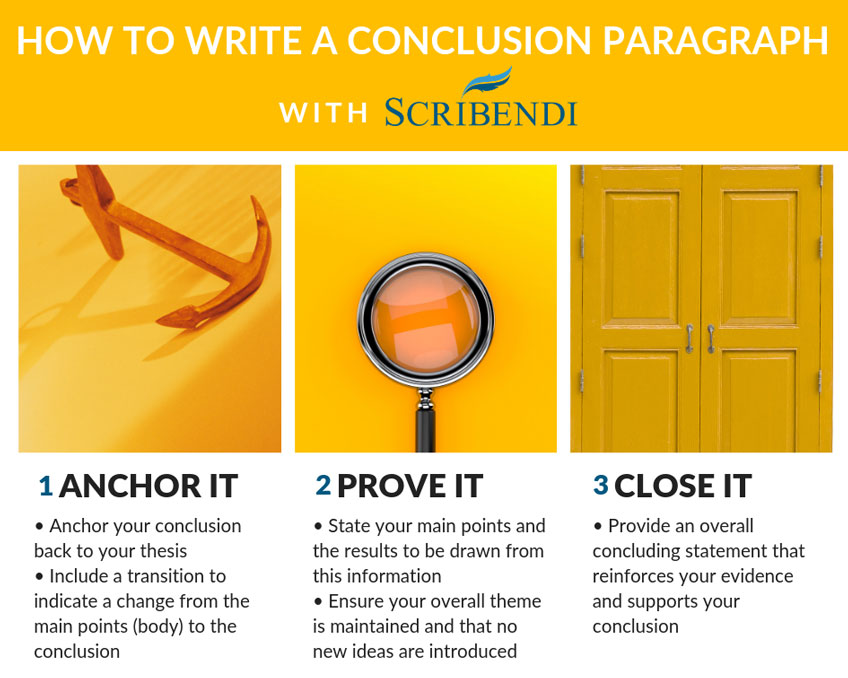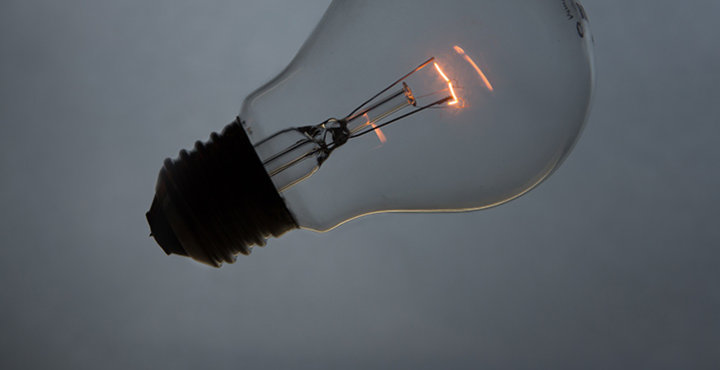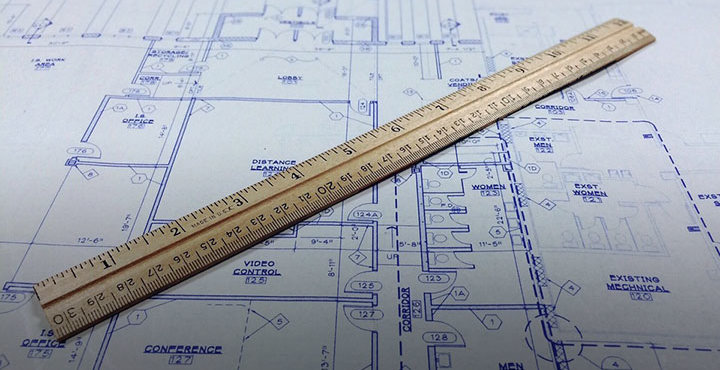Written by Scribendi
If you've ever seen or read about a great lawyer (or watched a great actor play a great lawyer) in action, you know that a key element in winning a case is the closing argument.
The same goes for the concluding paragraph in a piece of writing.
The conclusion is your last opportunity to persuade your reader that the information you just imparted is significant. This is particularly important because a reader will typically remember the conclusion paragraph more vividly than the beginning of your paper. (Thank you, recency bias!)
Luckily, we've crafted a foolproof, three-step method to show you how to write a conclusion. Let's dive in!
Step 1: Anchor It
A good conclusion paragraph begins by transitioning your message from the body of your paper to the conclusion and anchoring it to your thesis statement.
A transitional phrase should be used in the opening of your conclusion; consider using a phrase like "it is clear," "it is evident," or "overall." Similarly, a lawyer might begin their closing argument with a line like "without a doubt." This sentence will set the tone for the rest of the concluding argument.
Rephrasing your main point to establish your conclusion and tie all your arguments together is an effective way to kick off the paragraph and begin to bring your thought process full circle for your reader.
Step 2: Prove It
Every good lawyer's closing argument is presented with intent and persuasion. Lawyers explain why their evidence is superior to that of the opposing council and why the judge or jury should consider their arguments when arriving at a verdict. This is what your conclusion paragraph should also achieve.
Your conclusion is the big finish to your paper. Be careful not to repeat your introduction or main ideas verbatim. Instead, you want to summarize your evidence while reminding the reader why it is significant in the context of your paper.
In the courtroom, once the closing argument has begun, a lawyer will try to persuade the jury to consider all of the valid points they presented throughout the case and why that evidence matters—similarly, you should explain to your reader why they should care about what you said in your paper.
To begin this process, review the main points you made within your paper. Create a summary of each point as well as the significant contributions each makes to your argument. Next, concisely present each summary in a sentence or two for the reader.
Think of it this way—if a lawyer's client has an alibi supported by their employer and colleagues that they were at work when a particular crime took place, the lawyer might summarize this finding as follows:
The alibi provided by my client's employer and colleagues indicates that there were no plausible means by which my client could have left the office, robbed the bank, and made it back to their desk without being noticed. The time required to travel between these locations is too significant for this to be possible; no person could have successfully accomplished this task without their absence being noted.
Use transitional phrases to move from one idea to the next. Consider how each point works in tandem with the others to arrive at the conclusion you have drawn—or want the reader to draw—from your work.
If our hypothetical accused has an alibi, an eyewitness description of the actual culprit, and no DNA evidence placing them at the scene of the crime, then a seamless summary of these facts using this advice may read as follows:
The alibi provided by my client's employer and colleagues indicates that there were no plausible means by which my client could have left the office, robbed the bank, and made it back to their desk without being noticed. The time required to travel between these locations is too significant for this to be possible; no person could have successfully accomplished this task without their absence being noted. Furthermore, a key witness stated that the perpetrator of this crime was a Caucasian male with blonde hair and a tall frame. My client is not only female but also stands at a height of only 5'2"; this is a clear indication that my client's appearance does not align with the eyewitness's account of the true culprit's appearance. These key description discrepancies are only furthered by the lack of DNA evidence produced by the prosecution.
As you can see here, each idea supports one overall theme and provides evidence that leads to a verdict or a conclusion (i.e., innocence). This evidence is used to persuade the target audience (in this case [pun intended], the jury). Similarly, your conclusion should present evidence to convince your reader to agree with your main argument.
In the final sentence(s) of your conclusion paragraph, you need to bring your desired conclusion to light. Leave the reader feeling as though your evidence is, without a doubt, valid. Accordingly, the lawyer of the hypothetical client accused of bank robbery may read a closing sentence similar to the following:
Not only has the prosecution failed to produce any substantially valid evidence against my client, but the evidence that has been presented in this court further supports my client's innocence. Therefore, we ask the jury to render a verdict of not guilty.
Step 3: Close It (Flawlessly)
If you were undergoing the trial of a lifetime, you would want your lawyer's closing statements to be delivered flawlessly and without hesitation. The same is true for your conclusion paragraph. To be persuasive and convincing, it needs to be logical, coherent, and grammatically correct.
Once you have written the first draft of your conclusion paragraph, take a moment to reread it. Ensure that you have indicated a transition from the body of your paper to your conclusion and that the key elements of your paper are anchored on your overall argument.
Make adjustments to your statements to ensure that they are concise, accurately reflect your intention, and explicitly provide the evidence required to support your claims. Furthermore, check that you did not introduce any new major ideas (these should all be discussed in the main body of your work).
Then, ask a friend or—better yet—a professional essay editor to edit your paper. This step may seem inconsequential; however, the most minor details and adjustments can truly empower and sculpt an argument.
How many shows or movies have you watched more than once? You may have observed that each time you rewatch certain scenes, you notice inconsistencies and inaccuracies. Editing a paper is no different. The editing process ensures that your ideas are clear of all ambiguities and errors and polishes your conclusion paragraph into a beautifully articulated reflection on your work as a whole.
Here’s an Example
If the thesis of your paper indicated that businesses would be more profitable if they adopted a four-day workweek to ensure higher employee engagement, then your concluding paragraph might be structured and written as follows using our foolproof, three-step method to writing a great conclusion paragraph.
Anchor It
It is clear that a four-day work week is beneficial for both businesses and employees.
Prove It
When an employee has a healthy work–life balance, they are more likely to be engaged when they are at work. As a result of this heightened engagement, the business can operate more efficiently, thus generating higher profits. Furthermore, if an employee is engaged, they are less likely to leave their organization, and instances of absenteeism will decrease. This will lower both hiring and turnover costs as well as benefit plan costs.
Close It (Flawlessly)
Although this business structure may require operational adjustments and potential increases in short-term costs, the long-term benefits are indisputable.
Conclusion
Using our three-step method, you, too, can learn how to write a conclusion paragraph. Just remember: practice makes perfect! No lawyer becomes great overnight, and the same goes for great writers.
Here's a handy graphic describing each step involved in writing a great conclusion paragraph. Feel free to download, save, and print it at your convenience.

Happy writing!
Image source: stevanovicigor/elements.envato.com
Polish Your Conclusion to Leave an Impact on Your Reader
Hire One of Our Expert Editors, or Get a Free Sample
About the Author
Scribendi’s in-house editors work with writers from all over the globe to perfect their writing. They know that no piece of writing is complete without a professional edit, and they love to see a good piece of writing turn into a great one after the editing process. Scribendi’s in-house editors are unrivaled in both experience and education, having collectively edited millions of words and obtained nearly 20 degrees collectively. They love consuming caffeinated beverages, reading books of various genres, and relaxing in quiet, dimly lit spaces.






